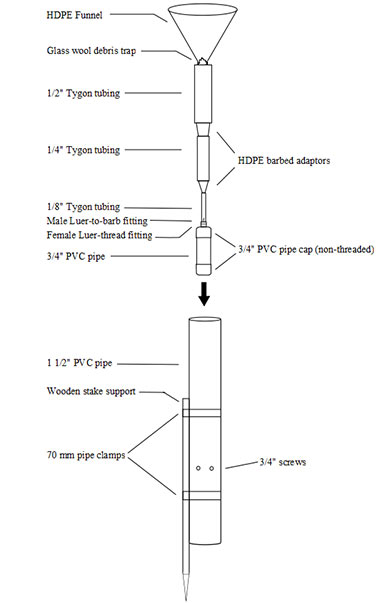2012 Senior Thesis Abstracts
(CLASS OF 2012: If your thesis abstract is not currently included on this page and you would like it to be, please follow this link.)
Investigating the Shelterin Complex in Xenopus laevis: TRF1 and PinX1 Interaction in an In vivo Model
Gleb Bazilevsky
(Advisor: Shampay)
Eukaryotes with linear chromosomes are faced with the challenge of maintaining their DNA in the face of DNA degradation with every instance of DNA replication. This has produced the ingenious solution of noncoding tandem repeats at the chromosome ends, called telomeres, which bear the brunt of these degradation events while safeguarding the rest of the chromosomes' genetic content. The telomeres are themselves protected by the enzyme telomerase, and the activity of telomerase is regulated in part by a six-member protein complex that sits on the telomere, called shelterin. Interestingly, the African clawed frog, Xenopus laevis, is characterized by the unusual pattern of high telomerase expression in most adult somatic cells, presenting the question of how telomerase is regulated in this altered scheme. In mammals, inhibition of telomere lengthening depends on the direct interaction between the shelterin component TRF1 and the accessory factor PinX1. This study asked if this interaction was also found for the orthologous proteins xlTRF1 and xlPinX1 from X. laevis. The possible interaction of the two proteins was modeled in silico, with the analysis indicating the loss of some key interactions. This failed to support the hypothesis that models of xlTRF1 and xlPinX1 would exhibit the same residue interactions seen between human TRF1 and PinX1. To assay for interaction in vivo, epitope-tagged versions of full-length xlTRF1, xlPinX1 and the xlTRF1 dimerization domain were constructed for transfection into mouse embryonic fibroblast cells, and tested for direct interaction via co-immunoprecipitation assay. In vivo, it was observed that xlTRF1 was capable of homodimerization (an important component of inhibition), but this study could not conclusively detect an interaction between xlTRF1 and xlPinX1. This suggests a mechanism of telomerase inhibition that may be significantly distinct from that of mammals, warranting further investigation of the X. laevis shelterin complex.
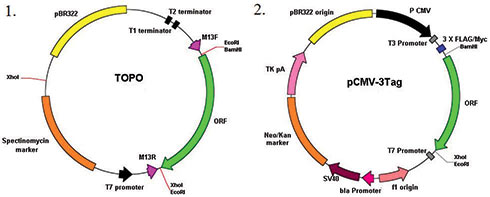
Figure A. Vector Constructs.
Diagrams of plasmid constructs, produced using "Plasm" plasmid drawing software (freeware from https://biofreesoftware.com/plasm). (1) TOPO construct with general features. The plasmid size without insert ORF is 2800 bp, and with the flxTRF1, xTRFH, or flxPinX1 inserts the size becomes 4095 bp, 3466 bp or 3903 bp, respectively. The plasmid contains EcoRI restriction sites flanking the insert and confers spectinomycin resistance. (2) pCMV-3Tag destination vector general features, including either 3XFLAG or 3XMyc epitope. The vector size is 4200 bp, and with the flxTRF1, xTRFH, or flxPinX1 inserts the size becomes 5495 bp, 4866 bp or 5303 bp, respectively.
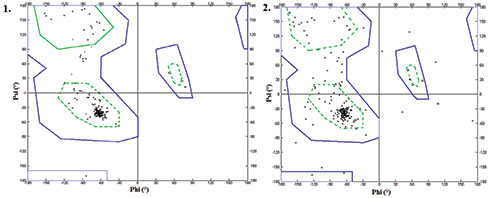
Figure B. Homology Model Accuracy Analysis.
The homology modeling of xTRFH shows increased torsional strain. (1) Ramachandran plot for the backbone phi and psi angles of the hTRFH structure from Chen, et al. 2008. (2) Ramachandran plot for the predicted xTRFH model backbone phi and psi angles. The regions enclosed by the solid boundary designate combinations with permissible torsion strain, while those circumscribed by the dashed line designate favorable combinations with minimized torsion strain energy. The plots were produced using the DeepView analysis and alignment software (Guex and Peitsch, 1997).
Inhibition of Telomerase by Xenopus laevis Partial xPinX1 Proteins
Isabel Cylinder
(Advisor: Shampay)
The ends of linear eukaryotic chromosomes are protected by DNA and protein structures called telomeres, which help to maintain chromosome stability. The enzyme telomerase is responsible for elongating these telomeres when they reach critically short lengths. In humans, the accessory protein PinX1 has been found to inhibit telomerase activity through a C-terminal 74-amino acid telomerase inhibition domain (TID). Xenopus laevis has recently been shown to possess a PinX1 homolog, xPinX1, which has been found to inhibit both human and X. laevis telomerase. However, when compared with human PinX1, the C-terminus of xPinX1 is poorly conserved, and it is unknown whether xPinX1 inhibits telomerase in the same way as human PinX1. Plasmids encoding three overlapping segments of xPinX1 were transformed and expressed in E. coli and purified. These purified proteins were analyzed using Telomeric Repeat Amplification Protocol (TRAP) assays to determine if any of the partial proteins were able to inhibit telomerase in vitro. The C-terminal partial xPinX1 protein, containing the putative TID, was shown to inhibit telomerase activity in vitro. Thus, it is proposed that Xenopus laevis PinX1 inhibits telomerase activity in the same manner as human PinX1.

Zinc-Mediated Downregulation of Virulence Genes in Enteropathogenic Escherichia coli (EPEC) by rpoE
Neil Evans
(Advisor: Mellies)
Diarrheal disease affects billions of people every year and kills millions. Recent evidence has revealed that zinc taken orally can lower the mortality caused by diarrhea. The mechanism behind zinc's action is not understood, though it appears that zinc is directly influencing the bacteria that invade the gut. Prior work has shown that zinc reduces the expression of virulence factors. This study further verified the existence of zinc-mediated downregulation of virulence factors, and explored membrane stress as zinc's mechanism of action. β-Galactosidase assays of bacterial virulence genes LEE1- lacZ, LEE4-lacZ, and LEE5-lacZ show statistically significant downregulation in the presence of zinc in Enteropathogenic Escherichia coli (EPEC) and the lab strain Escherichia coli MC4100. Bacteria with and without zinc were viewed by Transmission Electron Microscopy to provide further evidence that zinc causes membrane damage. The micrographs revealed membrane stress in two ways: through membrane vesicle formation and inner membrane irregularities. This supported the hypothesis that zinc's mechanism of action for virulence suppression is through membrane stress. The transcription factor σE, encoded by the rpoE, has been implicated in the environmental stress response. To test the hypothesis that the σE pathway contributed to zinc's virulence suppression, various membrane stressors that activate stress pathways in EPEC E2348/69 were studied. These microscopy experiments revealed similarities between the effects of 4% EtOH, a known σE activator, and zinc on the bacterial membrane. Meanwhile, activators of other membrane stress pathways Cpx and BaeSR showed unique phenotypes not shared with zinc. In contrast, β-galactosidase assays showed that the rpoE-lacZ in both strains is downregulated in the presence of zinc. Our β-galactosidase assay demonstrated a decrease in rpoE expression; while our TEM micrographs clearly revealed evidence of membrane stress indicating there is upregulation of some membrane stress pathways.
A Little Motherly Inhibition: The Effects of Postnatal Maternal Care on Astatotilapia burtoni
Christopher David Galvin
(Advisor: Renn)
Organisms, in response to stressors from the environment, immediately initiate their "flight or fight" response. This survival behavior is mediated through a hormone cascade called the hypothalamic pituitary adrenal (HPA) axis. Upon initiation of the HPA, the organisms release corticosteroid hormones, which are vital to the organisms' survival. The behavioral and physiological alterations associated with the "flight or fight" response are mediated through glucocorticoid receptors (GR) within target tisues. Once the stressor ceases to be a threat, the organism must "turn off" its stress response, which, in mammals, is mediated through GR within hippocampal neurons through negative feedback. In rats, early life experience, especially from maternal care, has been shown to have a profound effect on GR expression within the hippocampus, thus affecting the negative feedback of the HPA axis. Thus, rats with "bad" mothers have a lower expression of GR within the hippocampus and consequently decreased negative feedback within the hippocampus and subsequently prolonged HPA activity.
This current study examined, whether maternal care plays a pivotal role in normal development of the HPA axis in the cichlid fish Astatotilapia burtoni. First, a protocol was set to test this phenomenon within the teleost homolog to the mammalian hippocampus, the pallium. Then the liver was tested to determine whether an upregulation of GR expression was evident, a known target of cortisol. To test this, fry were reared either with or without their mother to simulate "good" and "bad" mothers. Gene expression of GR was evaluated with quantitative real-time PCR. The test resulted in no significant differences in GR concentrations within the liver between conditions, suggesting rearing conditions did not differ. However, since behavioral differences in mammals are mediated through GR within the brain, an investigation of neural differences must first be conducted before a negative result is definitely demonstrate.
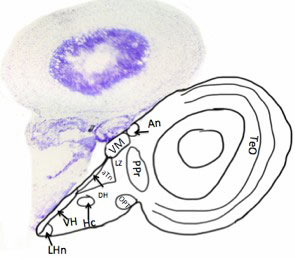
Characterizing the interaction between Xenopus laevis TRF2 and TIN2
Jeffrey Michael Hunter
(Advisor: Shampay)
Telomeres are terminal regions of chromatin comprised of repetitive DNA sequences that protect chromosomes from degradation caused by incomplete DNA replication. The telomeric regions are bound by the six-subunit shelterin complex that regulates extension of the telomeres by the ribonucleoprotein telomerase. In humans, the TRF2 subunit is one of the shelterin proteins that bind to telomeric DNA, and the TIN2 subunit acts as a lynchpin by binding TRF2 with the rest of the shelterin complex. The orthologous TRF2 from Xenopus laevis has been shown to bind telomeric DNA in vitro, but no interaction between X. laevis TRF2 (xTRF2) and TIN2 (xTIN2) has yet been demonstrated. This study seeks to examine this potential interaction through the use of the yeast two-hybrid system. Yeast cells with constructs of xTRF2 or xTIN2 fused to portions of Gal4 were used. Proteins that interact bring the two halves of the Gal4 protein together, promoting expression of LacZ which in turn encodes β-galactosidase. The cells were then assayed for β-galactosidase to determine interaction. The N-terminal half of xTRF2 was found to bind the N-terminal half of xTIN2, indicating a divergent interaction compared to the human homologues. Additionally, the C-terminal half of xTIN2 showed activity when fused to the binding domain of Gal4, suggesting that xTIN2 C-half is capable of either acting as a transcription factor or recruiting an endogenous yeast transcription factor.
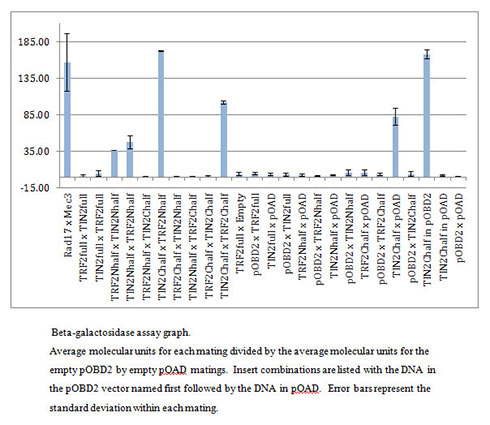
Fas and Fas Ligand in the Jurkat and B3B7 cell lines: a comparison of apoptotic protein expression in human and amphibian cancer cells
Elizabeth Anne Montgomery
(Advisor: Ruben)
It has been observed that amphibians have a much greater resistance to cancer, than mammals, but it is not known why. Among the possibilities that have been investigated, the differences in apoptosis and the regulation by the p53 protein stand out because of the varying apoptotic responses that mammalian and amphibian cells have to stress.
The p53 protein is able to cause apoptosis through both the intrinsic and extrinsic pathways, and it has been shown that both pathways are utilized to cause apoptosis in human Jurkat lymphoma cells. In the B3B7 cells, a cell line derived from Xenopus, the pathways used for apoptosis are unknown, and it is possible that the mechanisms these cells use in their response to damage and stress may play a significant role in their resistance to cancer.
To study this, the constitutive and upregulated expression of the Fas receptor (Fas) and Fas ligand (FasL) were studied, as they play a major role in the extrinsic apoptotic pathway. In these experiments, fluorescent staining of the two proteins was used to determine the location and amount of upregulation after different treatments, and FACS analysis was used to quantify the amount of constitutive and upregulated proteins. In the experiments it was found that the two cell lines have different susceptibilities to apoptosis depending on the treatment, and the data suggested that different apoptotic pathways may be used.
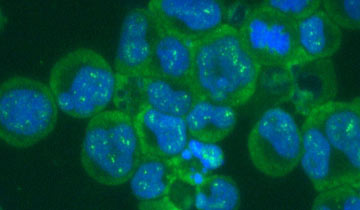
Phenology and Morphology of Taricha granulosa Overwintering Larvae and Aquatic Adults in Reed College Canyon: Implications for Ecological Restoration
Mathilde Braley Mouw
(Advisor: Kaplan)
Ecological restoration is the broad term for restoring a degraded environment to an ecologically functional state. Since 1999, Reed College has been restoring the Canyon to a native floral community by regularly weeding out invasive species and encouraging surviving natives to take over the empty spaces left in their place. Monitoring amphibian fauna could provide a good metric for studying whether the Canyon restoration is successful on multiple trophic levels, especially for species that are not actively managed.
Taricha granulosa, the rough-skinned newt, was discovered in the Canyon by Ashley Rogers (2005). The present thesis study describes the overwintering larvae and seasonal breeding adult newt populations in Ritmanis Pond, at the east end of the Canyon. Morphological changes of larval newts over the winter and morphological differences between sexes in breeding adults were quantified. Taricha granulosa were also found breeding in the new pond, Fisher 4, built in 2009 just north of Ritmanis Pond. These were included in the morphological survey of adult breeding newts. Larvae were found to increase in size and develop a longer tail length:snout-vent length (SVL) ratio over the course of the winter. Male adult newts were found to have smaller body width, longer tail length, and greater head width than females. There was no significant difference between SVL in male and female adult breeding newts.
Attempts were made to examine the terrestrial juvenile and adult newts that may remain in the Canyon after leaving Ritmanis Pond. Only two terrestrial newts were found in this study, possibly because of the dry weather this winter, so statistical analysis of terrestrial newt morphology or spatial dispersion was impossible.
Seven years after their discovery, Taricha granulosa occupy the Canyon year-round in various life stages. Their re-colonization of the east end of the Canyon indicates that the area is recovering and approaching a native state, nurturing native biodiversity around the oldest natural lake in the city.

Neuropeptides and sex-biased behavior: Arginine Vasotocin and Isocin in Julidochromis
Morgan Anderson Movius
(Advisor: Renn)
Differences between behavioral phenotypes are often correlated with changes in the underlying morphology of cells within the central nervous system, suggesting that changes in cell morphology are an important mechanism in the regulation of behavior. This study investigated the relationship between cell morphology and behavioral phenotype in two species of Julidochromis, a cichlid genus that contains species that display both conventional and reversed sex-biased behaviors. The genetic similarity of these species makes them an ideal system in which to investigate the neural mechanisms underlying the formation of sociosexual behaviors, particularly aggression in dominant J. marlieri females and dominant J. transcriptus males. Previous work in these species have shown an increase in the amount of arginine vasotocin and isotocin mRNA produced in the both dominant phenotypes, suggesting that these peptides play an important role in the regulation of aggression in these species. Research in other teleost systems have found correlations between behavioral phenotype and cellular morphology measurements, particularly cell size and cell number, indicating that changes in the underlying neural structure may influence the mechanism by which peptides are regulated in the development of behavior. Using immunohistochemistry, this study compared the size, number, and distribution of arginine vasotocin and isotocin producing cells within the preoptic area of J. marlieri and J. transcriptus males and females. Cell number results showed a significant increase in the number of isotocin producing cells in J. marlieri females, suggesting that these animals are increasing isotocin production by increasing the number of isotocin producing cells. J. transcriptus males did not show an increase in cell number, suggesting that J. transcriptus may be increasing isotocin production by different a mechanism.
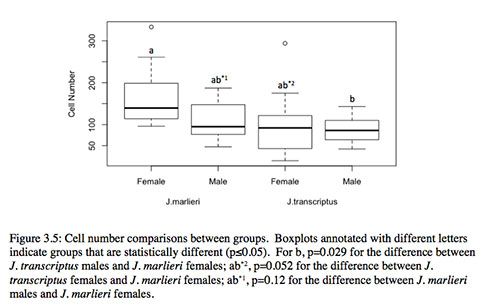
From Mom's Metabolism to Child Cannibalism: Feeding Regulation in the Maternal Mouthbrooder Astatotilapia burtoni
Nathaniel David Raley
(Advisor: Renn)
Renn laboratory maintains two genetically distinct lineages of mouthbrooding cichlid species Astatotilapia burtoni—an inbred laboratory stock that has been raised in captivity for over 30 years, and a wild-caught stock recently acquired from Lake Tanganyika, Zambia. Mothers from the lab stock frequently eat their offspring and display less maternal aggression than their wild counterparts; conversely, wild stock mothers of A. burtoni display a wide range of "good" maternal behaviors, including aggression towards conspecifics, and they do not eat their own fry. The inbred laboratory stock has been shown to lose more body mass while mouthbrooding than does the wild stock; this observation suggests an inability of laboratory stock fishes to appropriately decrease metabolic rate during the brooding period and implies a relationship between maternal care phenotype and the ability to regulate metabolism.
This study set out to determine whether there are whole-organism differences in metabolism and feeding regulation between laboratory stock and wild stock A. burtoni females undergoing a period of starvation, and whether brooding-induced starvation affects female A. burtoni differently than non-brooding starvation. Gross weight changes, measurements of metabolic rate, and assays for differential expression of feeding-related neuropeptides provided three levels from which to zero-in on the mechanisms of metabolism during mouthbrooding. This experimental tack allowed for the diagnosis of metabolic irregularity and separated the reproductive context of brooding from the act of starvation.
The present study reveals that during conditions of brooding-induced or exerimentally controlled starvation, laboratory stock A. burtoni are not able to appropriately reduce their metabolic rate and so expend more energy in the absence of energy intake. In addition, neuropeptide Y (NPY), a strongly orexigenic (appetite stimulating) neuropeptide integral to feeding regulation, was found to be expressed at higher levels in laboratory stock fishes in these same conditions. The results of this study are foundational; they represent a logical starting-place to begin to tease apart the intricacies of feeding and its relationship to behavior.
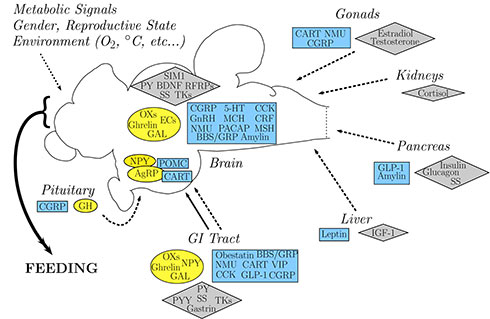
Effects of Nitrate Exposure on Daphnia pulex: a Whole Organism Study of Toxicity
Sarah Bluma Semon
(Advisor: Schaack)
This study examines the effects of sodium nitrate exposure on Daphnia pulex, a freshwater micro-crustacean, at both the level of gene expression and fitness-related traits. A microarray analysis was performed using both one-color and two-color competitive hybridization of cDNA generated by reverse transcription of RNA isolated from both control and exposed animals. The data show differential gene expression among groups and the probes exhibiting the largest fold difference were used as queries to identify up- and down-regulated genes. Exposure effects were also measured using phenotypic assays to compare survival, fecundity, body size, and behavior among treatments. Nitrate exposure was found to affect Daphnia pulex at the gene expression level, but no evidence for an effect of exposure was discovered.
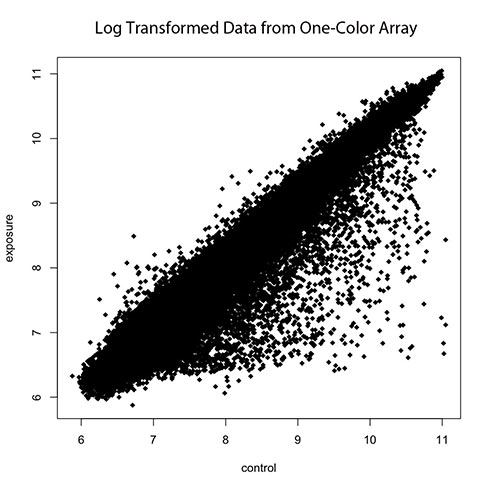
The generation and analysis of neutral genetic markers in Delphinium nuttallii using the ISSR technique
Christine Elizabeth Short
(Advisor: Karoly)
Delphinium nuttallii is a larkspur species native to the Pacific Northwest. Its range spans about 200 km in both Washington and Oregon along the Columbia River Gorge, as well as southwestern Washington and the northern Willamette Valley. D. nuttallii possesses a non-randomly geographically distributed polymorphism in its ribosomal RNA: a single nucleotide polymorphism (SNP) in the 5.8 S ribosomal RNA gene, which results in two different forms of the same molecule. One rRNA phenotype has been found in wetter habitats with warmer temperatures, such as the Willamette Valley and along the west end of the Columbia River. The other phenotype is primarily in colder and drier areas, such as along the eastern Columbia River and southwest Washington. Previous environmental research and rRNA folding models suggest that the phenotype located in warmer locations is more stable at high temperatures. This potential environmental effect on the rRNA polymorphism indicates that natural selection may be a potential instigator of its nonrandom geographic distribution.
In this study, I examined various genetic analysis techniques for feasibility, replicability, and statistical rigor. I then used the inter-simple sequence repeat (ISSR) technique to generate neutral, variable genetic markers with one primer that was optimized for replicable amplification based on a temperature gradient. Each of thirty- one marker loci were scored for ten plants from eight populations spanning D. nuttallii's entire geographic range. The markers were used to investigate the pattern of genetic variation within and between the D. nuttallii populations. The differentiation measured with the ISSR loci (FST = 0.0185) was much lower than the genetic variation measured for the rRNA genotype data (FST = 0.7037). This implies that the rRNA polymorphism is shaped by natural selection rather than genetic drift.

Pollinator specificity in the yucca moth/Josh tree obligate pollination mutualism: implications for coevolution and codivergence
Emily C. Thornquist
(Liaison advisor: Renn)
It has been theorized that some coevolutionary interactions can faciliatate codiversification, the simultaneous speciation of two species (Keister, 1984; Yoder and Nuismer, 2010; Poisot et al., 2011); however, this process has not been demonstrated empirically. The yucca moth/ Joshua tree obligate pollination mutualism represents a model coevolutionary relationship in which to examine this question because it features two recently diverged pollinator species (Tegiticula antithetica and Tegiticula synthetica) interacting with two, morphologically distinct varieties of Yucca brevifolia (Y. b. jaegeriana and Y. b. brevifolia) to which the moths are phenotype-matched. The two varieties exist in parapatry, with only one contact zone, located in Tikaboo Valley, Nevada.
Within the yucca moth/Joshua tree system, female moths gather pollen and store it under their heads. These moths then oviposit into the tree's developing fruit and pollinate the flower into which they deposited their eggs. This pollination behavior was used to gain a better understanding of the ways in which coevolution and codiversification interact within this system because moth pollination behaviors have a direct effect on plant genotype frequencies. Female moths were dissected and assigned species identity based on wing length, and microsatellites were amplified from DNA extracted from the pollen underneath the moths' heads. The Bayesian clustering program Structure was used in identifying the species of tree from which pollen was collected, and a pairwise analysis was performed to establish whether a relationship existed between moth species and the origin of the pollen loads they carried. That is, to establish whether pollinators were specific in their pollen collection. It was found that moth species shared a significant relationship to pollen identity (Fisher's exact test, N=41, DF=4, p<0.0001) and that moths carried pollen from trees to which they were phenotype matched more often than expected by random chance. This pollinator specificity suggests that coevolutionary interactions may play a role in codiversification; however, the existence of one T. synthetica moth carrying pollen from a non-phenotype-matched tree (Y. b. jaegeriana) throws some doubt on this conclusion.
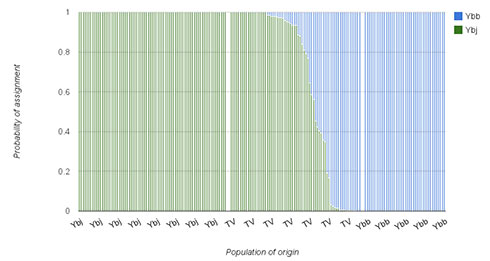
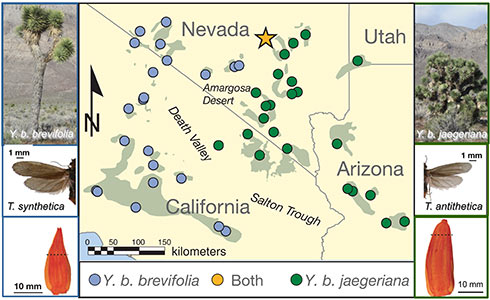
Characterization of Regulatory T cells with the Chemokine Receptor CCR6 in the Experimental Ovalbumin-Induced Uveitis Murine Model
Jessica Dan Que Tran
(Liaison Advisor: Arch)
One model used to study uveitis is the experimental ovalbumin-induced uveitis (EOU) mouse model. Autoimmune uveitis is a T cell-mediated inflammatory eye disease whose pathogenesis is not yet clearly understood. Recently, the EOU model has been used to visualize infiltration of Foxp3-GFP+ regulatory T cells and inflammatory effector T cells in the eye during the inflammatory process in vivo using non-invasive intravital epifluorescence microscopy. This finding is important because regulatory T cells (Tregs) are known for their ability to suppress inflammation, and thus have therapeutic potential. After confirming that Foxp3-GFP+ Tregs and inflammatory effector T cells infiltrate the eye in vivo after uveitis was induced, immunohistochemistry was used to characterize these cells with CCR6, a known Treg activation marker. The results showed non-specific binding of anti-CCR6 in the cornea, iris, and limbal regions of the eyes, which suggests that a different Treg activation molecule may be a better candidate to characterize Tregs in the EOU model, or that ex vivo experimentation may not provide adequate support for preserving fluorescence in the EOU model.
Constructing a Nitrogen Budget of the Reed College Canyon
Aaron Hiroshi Webb
(Advisor: Dalton)
The nitrogen biogeochemical cycle is an intricate and complex system comprised of numerous processes that serve to convert nitrogen between various chemical forms. These processes are mediated both by biotic and abiotic agents. Nitrogen budgeting is a strategy used widely in agriculture and research forests that involves the balancing of nitrogen entering and leaving a localized ecosystem. Detailed information on nitrogen cycling is important for the prevention of pollution. Nitrogen cycling information is also important on a global scale; monitoring nitrogen fluxes over time elucidates trends in anthropogenic nitrogen input. To assess nitrogen cycling in the Reed College canyon, I gathered data to quantify sources of major nitrogen input (biological nitrogen fixation and atmospheric deposition) as well as major nitrogen output (streamwater efflux). The data I collected was not sufficient of itself to generate a nitrogen budget, so it was supplemented with data gathered from national monitoring programs – atmospheric deposition data was gathered from the National Atmospheric Deposition Program (NADP) and streamwater data was gathered from the United States Geological Survey (USGS). Input of combined NH4-N and NO3-N through bulk atmospheric deposition was 1.84 kg N ha-1 yr—1. Input of nitrogen from biological nitrogen fixation could not be precisely determined, though nitrogen budgets with similar nodule biomass estimates suggest an accumulated input in the range of 85 kg N ha-1 yr-1. Sufficient amounts of data regarding ionic concentrations in streamwater were not obtained, resulting in the lack of an estimate for annual N output. These data provide estimates for N input, though significant further data collection efforts are necessary to establish a more complete picture of nitrogen cycling in the Reed College canyon.
